Abstract
Due to their imperative energy and creativity students are able to play the key role in solving social problems. University environment can be a catalyst element for raising community commitment by proposing an educational model, which will allow them to assimilate these new social roles. All bachelor students of Almaty Management University (AlmaU) attend courses of Service Learning (education through community service). Introduction of this discipline was a pioneering step of AlmaU and corresponds to its policy of socially responsible university, which aims the preparation of business specialists with social responsibility. During the Service Learning course, students are involved in activities valuable to the community. It is important that the students are free to make a choice of their involvement, form a team, propose and develop their own social project and implement it under the guidance of non-profit organization and professors. This creative environment and applied interactive education methods are uniting community commitment and education methods, raising the student’s interest for solving social problems and positive interpretation of this social experience. Two-years of studies of community commitment at AlmaU and practical results that were received have provided the basis for the structure of the educational process, which can be interesting for university community as a factor of increasing student’s social engagement and development of humanist, active and responsible community. This social result can be achieved only in case, when the community commitment will became a massive phenomenon of the educational environment, and will be supported by state, business and NGO.
Keywords: Student’s socializationcommunity commitmentService LearningAlmaty Management University
Introduction
The Kazakh society faced new challenges and problems during the formation of the new independent state. Deep processes of denationalization and liberalization affected not only the economic but also the social sphere, which inevitably led to a deterioration of socially unprotected citizens’ welfare. On the other hand, the able-bodied active part of the population forced to work in harsh conditions of competition and permanent financial and economic crises, has developed a sustainable pragmatic approach to many spheres of public life.
Pragmatism in the system of higher education is expressed by the fact that the training of specialists is emphasized basing on the professionalization of knowledge, skills and habits. At the same time, the extensive experience of foreign universities shows that university education forms not only professional competencies, but also the world outlook and values of the future specialist (Harkavy, 2006).
By the 1980s the term “service learning” was invented and defined as a pedagogical method (Umpleby & Rakicevik, 2007). There are main concepts that make service learning important in education. As Jacoby (1996) defines, “Service-learning is a form of experiential education in which students engage in activities that address human and community needs together with structured opportunities intentionally designed to promote student learning and development”. Now the practice of teaching and integrating service learning into education is the international reform movement, which has become increasingly popular among educational institutions in many countries, including Asia for the last three decades. (McCarthy, 2003; Butin, 2006).
Social association, moral and ethical culture of the student can become a guarantee of successful future career. The reality of the situation is that today’s employers are increasingly focused not so much on the skills of the applicant, as on the skills of self-regulation, labor motivation, readiness for improvement and empathy.
Problem Statement
Of the indicators in measuring social capital among the youth are participation in community and civic life, participation in youth community life, participation in youth-centred political activity (Billett, 2012). According to the “Youth of Central Asia. Kazakhstan” report prepared by the Friedrich Ebert Foundation, youth of Kazakhstan showed extremely low level of volunteering activity: 89.1% of respondents replied “no” to the question “if you have been involved in volunteering activity for the last 6 months”, with only 9.3% “yes” and 1.6% “difficult to answer”. Analysis of the motives of those respondent who participated in volunteering activity in last 6 months shows that “the desire to participate in social activity” was the major reason (52.7% of respondents) (Assylbekova, 2015).
The scientific research centre “Youth”, established by the order of the government, issued the National report on the youth of Kazakhstan (2014), which also reveals that youth organizations face the legitimacy crisis, which results in the decrease of young people in NGO sector, and not enough volunteering activity among youth.
Student community, as the most active part of society, due to the imperatively inherent high cognitive motivation and the need for self-realization, can show high social activity. The university environment can become a catalyst for the student's social involvement offering such educational model that harmoniously combines learning and socialization (Wagner, 2012).
In 2015, AlmaU, having studied the previous experience of Hong Kong Polytechnic University, introduced the new discipline "Service Learning" into the bachelor educational program. The introduction of this course into the training program was an innovative step on education market of Kazakhstan. For AlmaU, as for socially responsible university it has been natural development stage, as the university seeks to train professionals with a civil orientation and a sympathetic heart. In the process of studying on the "Service Learning" program, students were given the opportunity to learn new social roles and gain social experience, closely related to the humane attitude to the world around and active citizenship.
For the period of 2 years, 833 students accomplished their studies at AlmaU, covering over 45 social projects in cooperation with 24 public non-governmental organizations. For most of the training hours, students are engaged in performing socially useful work for the benefit of others. Wherein, students could choose the sphere of their volunteer activity, pick up a team, propose and develop their social project, and then implement it under the guidance of a non-profit public organization. Thus, the created space for initiative and the interactive methods of teaching allow to combine the goals of community service with the goals of education, increasing the interest and involvement of students in the process of solving of social problems.
Research Questions
3.1 The survey of AlmaU students has been taken as the basis for this paper to check if students who have taken courses with service learning appear to be more knowledgeable about and committed to serving their communities
3.2 How much the ‘Service learning’ studies influence the increasing of social contribution of student into resolving process of social problems.
3.3 If community service studies influence upon personal growth, the formation of citizenship and need for active empathy.
Purpose of the Study
The aim of the study was to find out how the AlmaU model of community service education was able to develop among the students their constant understanding, desire, and need to help people, society throughout the whole life.
During research process there was considered a task to study what first-year students know about volunteering, if there was any experience of serving the community and their common approach to this phenomena; to see students’ attitude of introduction of “Service Learning” class into University curricula; to identify the impact of studies and gained social experience on self-knowledge and self-development of the student; what were the causes impeded full and effective studies of that academic course; how much that training influenced the motivation and attitude of the students to volunteer activity, their level of awareness about the social problems, their willingness to contribute and express kindness and civic engagement.
Research Methods
Many scholars and educators analyses the impact of service learning on student’s performance, both academic and social sides (Berry, Chisholm, 1999). “Knowledge-experience-reflection” is the cycle necessary for successful implementation of service learning at intuitions (Vickers,Harris, & McCarthy, 2004).
As an experimental method to identify the effectiveness of community service studies, there was conducted sociological survey in the form of questionnaire.
In the period of 2016 – 2017 academic year among the students of Almaty Management University there was conducted sociological survey in the form of questionnaire, which was consisted of 2 stages. The initial survey was conducted in October of 2016. In May of 2017 right after the accomplishment of “Service Learning” class there was re-conducted sociological survey among the same students. The main aim of the survey was to see students’ attitude related to community service classes in university.
The sample size was represented by 400 1st year undergraduate students coming from different specialties and language study tracks. The age of the responders fluctuated from 17 to 19 years old; the share of students representing Russian language department was 72,4%, Kazakh – 15,1%, English – 12,5%. Proportion of females was 58%, males — 42%. The details of respondents’ breakdown are presented in Table
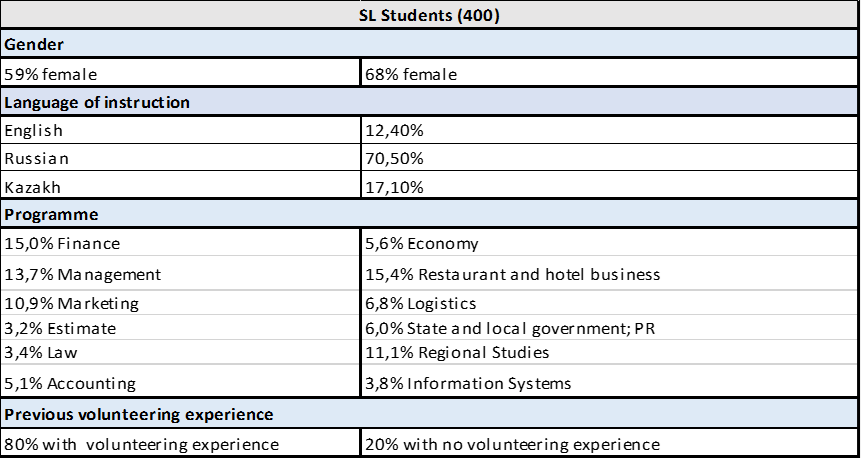
Findings
6.1.The results of the survey showed that 80% of students enrolled for 1 course had never participated in volunteer activity before. Only one student out of five respondents (20%) had previously had experience of socially useful activities on a voluntary basis. Most of this experience was obtained during schooling (college) (67.5%), as well as in the family (12.5%). Only five students (6.25%) systematically carried out volunteer activities in specific public organizations. 11 students (7.5%) indicated that they participated in one-off charitable public events (Figure
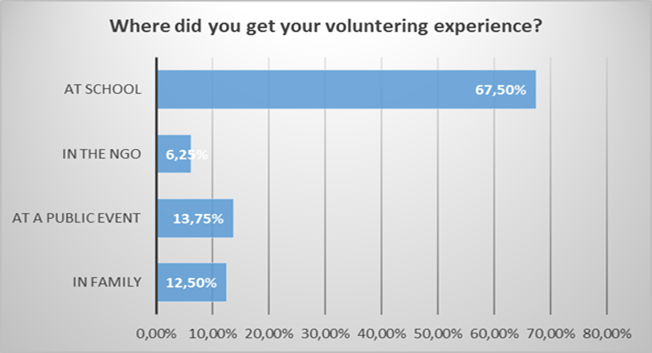
6.2.At the same time, in general, student youth is positive about volunteer activity (380 people or 95%), of which 71.5% are very good. 10 people (2.5%) did not work out their position in relation to volunteer work, and the same number treat it negatively (2.5%) (Figure
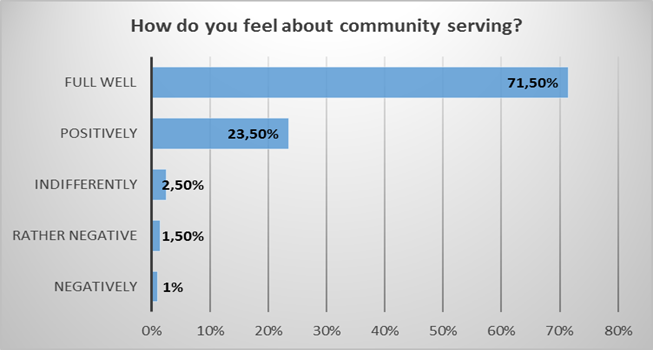
6.3.The majority of students (188 people or 47%) in volunteer activity primarily attract the opportunity to benefit people. For 78 students (19.5%) - this is a way of socializing and socializing. For every tenth person interviewed (11.25%) in volunteerism they see the possibility of acquiring a new experience. 13.5% of respondents consider service to society as an opportunity to show their activity and realize their own ideas. For some young people (8.75%) motives for volunteer work lie in the sphere of communication: to support the company of friends and acquaintances - 3%; To communicate with interesting people - 4%; To spend free time - 1,75%. Based on these answers, it can be concluded that the service to society in the perception of young people is mainly associated with altruism, with the opportunity to be useful to people and participation in public life (Figure
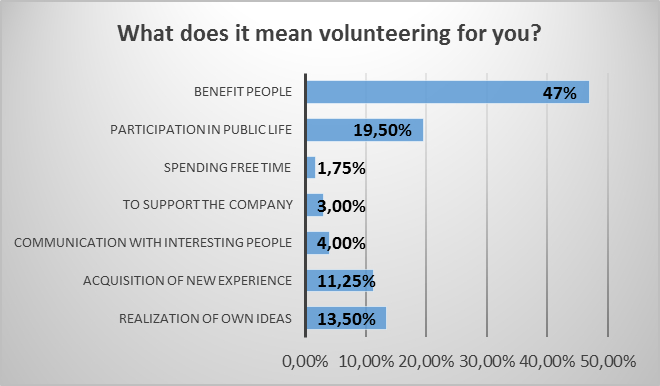
6.4.In the opinion of the respondents, the younger generation, students of higher education institutions (30%), secondary educational institutions (22.5%), and working youth (8%) are more likely to volunteer. One-third of respondents believe that volunteerism is mainly the part of well-off adults (36.5%). Students believe that indifference to the problems of society (159 people or 39.7%) hampers the development of volunteer activity in the youth environment; Among other reasons, indicate a lack of time (30.5%); Lack of experience in this field (11.75%) or information about charitable organizations (8.25%). Each tenth of the respondents believes that a serious obstacle to volunteering is the lack of financial opportunities (9.75%).
6.5.When asked if it is necessary to train in the service of society, most of the students answered positively (85.75%), and only 11 students (2.75%) answered negatively. 11.5% of respondents could not decide the answer.
As a result of studying the course "Service Learning" 61.25% of students changed attitudes towards socially useful work, yet one third of respondents (34.75%) had difficulty in answering this question, 16 respondents had the same attitude to volunteering.
From the point of view of the effectiveness of the training, 83% of the respondents indicated that their social work performed during the training in the "Service Learning" program benefited specific people or the community; 4% of respondents considered their work useless; 14% - could not assess their contribution. At the same time, the respondents named the most attractive and significant areas of socially useful activity: environmental protection; Assistance to orphans and disabled children; Development of sports among people with disabilities; Assistance to the elderly and veterans; Organization of charity events.
In general, the survey showed that according to the majority of students the training in the course "Service Learning" benefited them (332 people or 83%); 2% of respondents felt that they had not benefited from any benefit, and 14% of respondents could not decide on the answer.
Of the respondents who positively assessed the benefits to themselves from training in public service, 310 students (77.5%) noted that they received useful skills that would be useful for their future work. Among those who reacted negatively or neutrally to social practice in the program for serving the community, they perceived it as uninteresting work (3.5%) or wasted time (5%) (Figure

6.6. To the question that, in their opinion, hinders the process of teaching service to society, half of the respondents (49%) indicated indifference to the problems of society, which they encountered in the process of social practice. 21% of respondents noted that they did not praise time or experience (10.5%) for learning useful skills. 17 respondents (4.25%) did not see the connection between the knowledge and skills acquired during the course of the course "Service Learning" with their subsequent professional education. Respondents also noted that the deterrent factors of training are shortcomings in organizing and coordinating volunteer work by program administrators and partner non-governmental organizations (5%); Lack of support in volunteer work by teachers (1%); Unattractive for themselves areas of volunteerism, in which they had to participate (2.25%); As well as lack of incentives and motivation for voluntary work (2.5%) (Figure
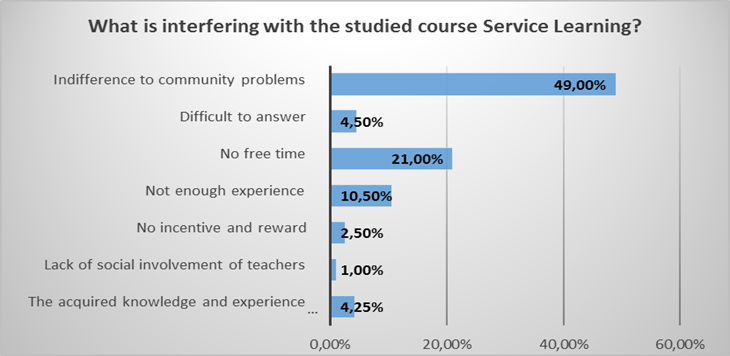
Conclusion
7.1.The results of the survey of newly admitted students to the university showed that young people as a whole positively perceive voluntary activities for the benefit of society, believes that it is the younger generation who can occupy it more often than others. However, as an investigation, the previous experience of volunteering was only a small part of freshmen. The majority of respondents, as a rule, are children from well-off families, were not interested in the problems of society before. A serious obstacle to volunteer work for respondents was low awareness of the activities of non-profit organizations, lack of appropriate organizational conditions for volunteer work.
7.2.An analysis of the results of a questionnaire survey of students who received academic training as part of the Service Learning course showed that the vast majority of respondents noted the importance of studying this subject and the usefulness of the social experience that they acquired while working in various projects with NGOs. Students noted the changes in their perception of the surrounding world and society, the expansion of the circle of interests and communication and psychological skills, the achievement of a higher level of self-knowledge and self-development. At the same time, the data obtained made it possible to point out a number of problems and shortcomings in the organization of the process and the methodology for teaching this academic course, which serves as the basis for the creative comprehension and development of the program of service to society at the university as a whole.
7.3.The results of the study made it possible to identify some problems and ways to increase the social engagement of students.
It is recommended to strengthen the academic aspects of the social involvement of students in the process of the entire period of study at the university. During teaching professional disciplines, it is advisable to link the subject and content of courses with the solution of specific social problems of society.
It is important to involve a greater number of faculty and staff in the curriculum development of public service teaching, by increasing the number of social cases in academic subjects, and by direct involvement in the process of providing social services together with students.
The achieved results on the expansion of the social involvement of student youth through training to serve the community testify to the advisability of promoting research in this direction and extending AlmaU's experience among universities to the educational environment of Almaty, Kazakhstan and the Central Asian region.
The case of teaching Service Learning shows the positive influence on students and to greater understanding of their role for community and their social engagement. The higher authorities in education should pay significant attention to incorporation of community engagement courses in universities and schools.
References
- Assylbekova, A.M. (2015). Social Engagement of Kazakh Students.Canada Review of European Studies; 7(6), 61-69. Retrieved from file:///C:/Users/usn/Downloads/47983-165116-1-PB.pdf
- Berry, A.H., Chisholm, L. (1999). A Service-Learning in Higher Education around the World: An Initial Look, International Partnership for Service-Learning, New York, NY.
- Billett, P. (2012). Indicators of youth social capital.Youth Studies Australia, International Education, 36(1), 23-40.
- Butin, D.W. (2006). Special Issue: Introduction Future Directions for Service Learning in Higher Education, International Journal of Teaching and Learning in Higher Education, 18 (1), 1-4.
- Harkavy, I. (2006). The role of universities in advancing citizenship and social justice in the 21st century.Education, citizenship and social justice, 1(1), 5–37.
- Jacoby, B. and Associates (Eds.). (1996). Service-Learning in Higher Education: Concepts and Practices. San Francisco, CA: Jossey-Bass.
- National Report “Youth of Kazakhstan – 2014” (Rep.). (2014, September). Retrieved August, 2017, from Scientific-Research Center “Youth”, 2014 website: http://elzhastary.kz/upload/iblock/afc/%D0%9D%D0%B0%D1%86%20%D0%B4%D0%BE%D0%BA%D0%BB%D0%B0%D0%B4%202014.pdf
- Umpleby, S. and Rakicevik, G. (2007). Adopting Service Learning in Universities around the World. Journal of the World Universities Forum, 1(2), 39-48.
- Vickers, M., Harris, C & McCarthy, F. (2004). University‐community engagement: exploring service‐learning options within the practicum, AsiaPacific. Journal of Teacher Education, 32(2), 129-141, DOI: 10.1080/1359866042000234223
- Wagner, I. (2012). Education and socialization of student youth in the process of higher professional education.Bulletin of the Moscow University named after S. Yu. Witte.Pedagogy. Educational resources and technologies, 1(3), 36-42. Retrieved from https://www.muiv.ru/vestnik/pdf/pp/pp_2013_1_68_74.pdf
Copyright information

This work is licensed under a Creative Commons Attribution-NonCommercial-NoDerivatives 4.0 International License.
About this article
Publication Date
16 April 2018
Article Doi
eBook ISBN
978-1-80296-037-2
Publisher
Future Academy
Volume
38
Print ISBN (optional)
-
Edition Number
1st Edition
Pages
1-509
Subjects
Social welfare, social services, personal health, public health
Cite this article as:
Massanova, L., Yelubaeva, Z., & Assemkulova, G. (2018). Education Environment As A Factor Of Social Engagement Of Students: Almau Case. In F. Casati, G. А. Barysheva, & W. Krieger (Eds.), Lifelong Wellbeing in the World - WELLSO 2017, vol 38. European Proceedings of Social and Behavioural Sciences (pp. 312-320). Future Academy. https://doi.org/10.15405/epsbs.2018.04.34

